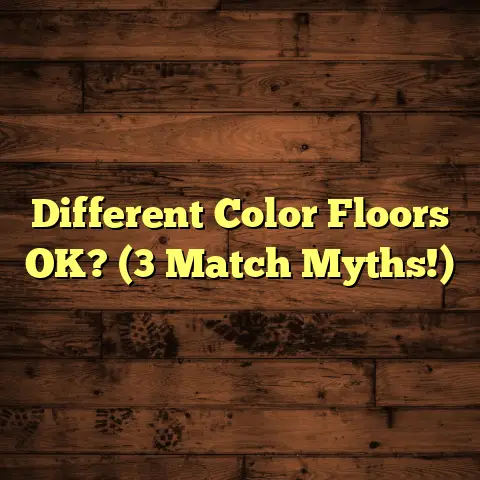Refinish Wood Floors? (6 Signs It’s NOW!)
And let me tell you, I’ve seen it all when it comes to wood floors.
From the gleaming, newly installed masterpieces to the poor, neglected planks begging for help.
Today, we’re diving deep into the world of wood floor refinishing.
We’re talking about when it’s absolutely necessary, and how to spot those telltale signs.
Think of your wood floors as more than just something to walk on.
They’re a testament to timeless beauty and the inherent craftsmanship of skilled artisans.
From selecting the perfect timber to the intricate milling and finishing processes, creating a wood floor is an art form.
It’s an investment in both aesthetics and durability.
And like any valuable piece of art, it needs proper care and upkeep to maintain its glory.
That’s where refinishing comes in.
So, grab a cup of coffee (or tea, I don’t judge), and let’s get started!
The Importance of Wood Floor Refinishing
So, what exactly is refinishing?
In a nutshell, it’s the process of sanding down the existing finish of your wood floors, repairing any damage, staining (if desired), and then applying several coats of a protective sealant.
Think of it as a spa day for your floors!
But why is it so important?
Well, for starters, it restores their beauty.
Over time, even the toughest finishes can wear down, leaving your floors looking dull and tired.
Refinishing breathes new life into them, bringing back that rich, warm glow.
But it’s not just about aesthetics.
Refinishing also extends the life of your floors.
By removing scratches, dents, and other imperfections, you’re preventing further damage and protecting the wood underneath.
And let’s not forget about home value!
A well-maintained, beautifully refinished wood floor is a major selling point.
It shows potential buyers that you take pride in your home and that you’ve invested in its upkeep.
Think about it: refinishing is like getting a fresh coat of paint on your walls, but with even more impact.
It can completely transform the look and feel of a room.
And honestly, regular upkeep, including refinishing, reflects your pride in craftsmanship and care for your home.
It shows you value the investment you’ve made and that you’re committed to preserving its beauty for years to come.
Understanding the Signs That It’s Time to Refinish
Okay, so now you know why refinishing is important.
But how do you know when it’s time to take the plunge?
That’s what we’re going to cover in this section.
I’m going to walk you through six key indicators that suggest your wood floors are crying out for a refinishing job.
Pay close attention, because catching these signs early can save you a lot of time, money, and heartache down the road.
Sign 1: Visible Scratches and Dents
Let’s face it: life happens.
We drop things, we drag furniture, our pets have accidents…it all takes a toll on our floors.
Over time, this wear and tear manifests as scratches and dents.
Now, a few minor scratches here and there aren’t necessarily a cause for alarm.
But if you’re starting to see a significant number of scratches, especially deep ones that penetrate the finish and reach the wood itself, it’s time to start thinking about refinishing.
These scratches not only detract from the beauty of your floors, but they also weaken the protective finish, making the wood more vulnerable to moisture and stains.
Dents, on the other hand, can be caused by heavy objects being dropped or by furniture legs digging into the wood.
Like scratches, dents can damage the finish and expose the wood underneath.
Minor vs. Severe Damage:
- Minor Damage: Surface scratches that don’t penetrate the finish, small dents that are barely noticeable. These can often be addressed with touch-up kits or by applying a fresh coat of wax.
- Severe Damage: Deep scratches that expose the bare wood, large dents that are easily visible, gouges, and areas where the finish has completely worn away. This type of damage requires a full refinishing job.
I’ve seen floors where the scratches were so deep, you could practically see the wood splintering.
That’s a clear sign that refinishing is needed ASAP!
Sign 2: Fading or Discoloration
Sunlight is great for our moods, but it can be a nightmare for our wood floors.
Prolonged exposure to UV rays can cause the wood to fade or discolor over time.
This is especially noticeable in areas that get a lot of direct sunlight, such as near windows or sliding glass doors.
But sunlight isn’t the only culprit.
Aging can also cause wood floors to lose their original luster and color.
The finish can become dull and cloudy, and the wood itself may start to look washed out.
Discoloration can also indicate that the protective finish is wearing thin.
When this happens, the wood is more susceptible to stains and damage from spills and other accidents.
I remember one house where the area rug had been in place for years.
When they removed it, the difference in color between the covered area and the rest of the floor was stark—a clear sign of sun damage.
Refinishing can restore the original luster and color of your floors, making them look brand new again.
You can even choose a different stain to completely transform the look of your room.
Sign 3: Water Damage or Stains
Water and wood don’t mix.
Spills, leaks, and even high humidity can wreak havoc on your wood floors.
When water penetrates the finish, it can cause the wood to warp, cup, or even develop mold.
Warping is when the wood planks start to bend and curve, creating an uneven surface.
Cupping is when the edges of the planks rise up, creating a concave shape.
And mold, well, that’s just a health hazard.
Water stains can also be a major problem.
If you spill something on your floor and don’t clean it up right away, it can seep into the wood and leave a permanent stain.
Pet urine is a common culprit, as is spilled wine or coffee.
Now, if you catch water damage early, you may be able to mitigate some of the effects with a thorough cleaning and drying.
But if the damage is extensive, refinishing may be the only option.
I’ve seen floors that were so badly water-damaged, they had to be completely replaced.
Don’t let that happen to you!
Keep an eye out for signs of water damage, and address them promptly.
Sign 4: Lack of Shine
Remember when your wood floors had that beautiful, glass-like sheen?
Over time, that natural shine can diminish due to wear and tear.
Foot traffic, furniture being dragged across the floor, and even regular cleaning can all contribute to a loss of shine.
A lack of shine can signal that the protective finish is no longer effective.
When the finish wears down, it becomes more porous, allowing dirt and grime to penetrate the wood.
This can make your floors look dull and lifeless, even after you’ve just cleaned them.
The aesthetic implications of dull floors are significant.
They can make your entire room look dated and uninviting.
Refinishing can restore their brilliance, bringing back that warm, inviting glow that makes your house feel like home.
Think of it as giving your floors a facelift!
Sign 5: Noise and Creaking
No one likes a noisy floor.
That annoying creaking sound can be a sign of structural issues or wear.
Sometimes, the nails or screws that hold the floorboards in place can loosen over time, causing the boards to rub against each other.
This can create a squeaking or creaking sound when you walk across the floor.
In other cases, the subfloor underneath the wood floor may be damaged or uneven, causing the floorboards to flex and creak.
Refinishing can sometimes address these problems, alongside other necessary repairs.
For example, when refinishing, I often replace loose nails with screws that are less likely to loosen over time.
I also inspect the subfloor for any signs of damage and make repairs as needed.
However, if the structural issues are severe, you may need to consult with a structural engineer before refinishing.
A quiet, well-finished floor reflects the quality of craftsmanship.
It shows that the floor was installed properly and that it’s been well-maintained over the years.
Sign 6: An Outdated Stain or Finish
Trends in home décor and personal taste change over time.
What was once considered stylish may now look dated and out of place.
If you have wood floors with an outdated stain or finish, refinishing allows you to update the look of your floors without having to replace them entirely.
For example, maybe you have dark, glossy floors that were popular in the 90s.
But now, you prefer a lighter, more matte finish that’s more in line with current trends.
Refinishing gives you the opportunity to completely transform the look of your floors by choosing a new stain and finish.
There are so many modern finishes and stains available today that can enhance the floor’s appearance and durability.
From natural, oil-based finishes to durable, water-based polyurethanes, the possibilities are endless.
I’ve helped countless homeowners update their floors to match their personal style and create a more modern, inviting space.
The Refinishing Process Explained
Okay, so you’ve determined that your wood floors need refinishing.
Now what?
In this section, I’m going to give you a comprehensive overview of the refinishing process, detailing each step from preparation to completion.
Step 1: Preparation
The first step is to prepare the area for refinishing.
This involves removing all furniture, rugs, and other items from the room.
You’ll also need to cover any doorways or openings to prevent dust from spreading to other parts of the house.
Step 2: Sanding
The next step is to sand down the existing finish of your wood floors.
This is typically done using a drum sander, which is a large, powerful machine that can quickly remove the old finish and smooth out any imperfections.
The sanding process usually involves several passes with different grits of sandpaper, starting with a coarse grit to remove the bulk of the finish and ending with a fine grit to create a smooth surface.
Step 3: Repairing Damage
Once the floors have been sanded, it’s time to repair any damage, such as scratches, dents, or gouges.
This can be done using wood filler or epoxy.
I carefully fill in any imperfections and then sand them smooth so they’re flush with the surrounding wood.
Step 4: Staining (Optional)
If you want to change the color of your floors, you can apply a stain after sanding.
There are many different types of wood stains available, ranging from light and natural to dark and dramatic.
I always recommend testing the stain on a small, inconspicuous area of the floor before applying it to the entire room.
This will give you a better idea of how the stain will look and allow you to make any necessary adjustments.
Step 5: Sealing
The final step is to apply several coats of a protective sealant to the floors.
This will protect the wood from scratches, stains, and other damage, and it will also enhance the beauty of the finish.
There are many different types of sealants available, including polyurethane, varnish, and lacquer.
I typically recommend using a polyurethane sealant, as it’s durable, water-resistant, and easy to clean.
Hiring a Professional vs. DIY Refinishing:
Now, you might be wondering if you can tackle this project yourself.
While DIY refinishing is possible, I generally recommend hiring a professional.
Refinishing wood floors is a labor-intensive and time-consuming process that requires specialized tools and expertise.
If you don’t have the right equipment or experience, you could end up damaging your floors or creating an uneven finish.
Plus, a professional will be able to handle any unexpected problems that may arise, such as hidden water damage or structural issues.
Tools and Materials:
- Drum sander
- Edger sander
- Detail sander
- Sandpaper (various grits)
- Wood filler or epoxy
- Wood stain (optional)
- Protective sealant
- Applicator pads or brushes
- Safety glasses
- Dust mask
- Hearing protection
Remember, quality and technique are key.
Using high-quality materials and following proper techniques will ensure that your refinished floors look beautiful and last for years to come.
Conclusion
So, there you have it: six key signs that indicate it’s time to refinish your wood floors.
- Visible Scratches and Dents
- Fading or Discoloration
- Water Damage or Stains
- Lack of Shine
- Noise and Creaking
- An Outdated Stain or Finish
If you’re noticing any of these signs in your own home, it’s time to take action.
Don’t wait until the damage becomes too severe.
Refinishing your wood floors is an investment in the beauty and value of your home.
It’s also a way to honor the craftsmanship that went into creating those floors in the first place.
So, take a good look at your floors.
Are they looking tired and worn?
Are they lacking their original luster?
Are they making your room look dated and uninviting?
If the answer to any of these questions is yes, it’s time to consider refinishing.
Don’t be afraid to reach out to a professional for an estimate and to discuss your options.
And most importantly, take pride in the maintenance of your beautiful wooden investment.
Your floors will thank you for it!





